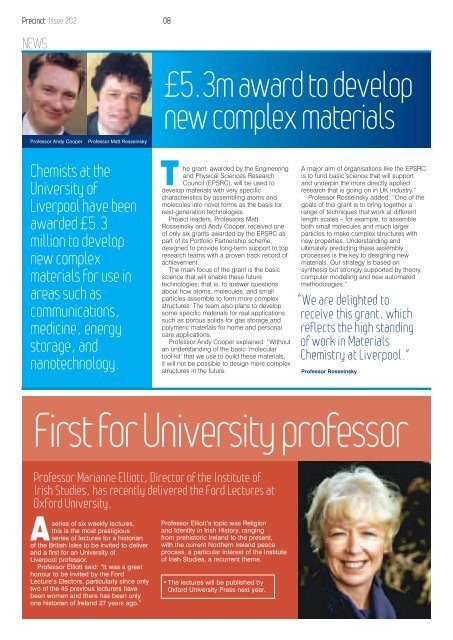Precinct April 05 - University of Liverpool
Precinct April 05 - University of Liverpool
Precinct April 05 - University of Liverpool
You also want an ePaper? Increase the reach of your titles
YUMPU automatically turns print PDFs into web optimized ePapers that Google loves.
<strong>Precinct</strong> Issue 202 08<br />
NEWS<br />
Pr<strong>of</strong>essor Andy Cooper Pr<strong>of</strong>essor Matt Rosseinsky<br />
Chemists at the<br />
<strong>University</strong> <strong>of</strong><br />
<strong>Liverpool</strong> have been<br />
awarded £5.3<br />
million to develop<br />
new complex<br />
materials for use in<br />
areas such as<br />
communications,<br />
medicine, energy<br />
storage, and<br />
nanotechnology.<br />
£5.3m award to develop<br />
new complex materials<br />
T<br />
he grant, awarded by the Engineering<br />
and Physical Sciences Research<br />
Council (EPSRC), will be used to<br />
develop materials with very specific<br />
characteristics by assembling atoms and<br />
molecules into novel forms as the basis for<br />
next-generation technologies.<br />
Project leaders, Pr<strong>of</strong>essors Matt<br />
Rosseinsky and Andy Cooper, received one<br />
<strong>of</strong> only six grants awarded by the EPSRC as<br />
part <strong>of</strong> its Portfolio Partnership scheme,<br />
designed to provide long-term support to top<br />
research teams with a proven track record <strong>of</strong><br />
achievement.<br />
The main focus <strong>of</strong> the grant is the basic<br />
science that will enable these future<br />
technologies; that is, to answer questions<br />
about how atoms, molecules, and small<br />
particles assemble to form more complex<br />
structures. The team also plans to develop<br />
some specific materials for real applications<br />
such as porous solids for gas storage and<br />
polymeric materials for home and personal<br />
care applications.<br />
Pr<strong>of</strong>essor Andy Cooper explained: “Without<br />
an understanding <strong>of</strong> the basic ‘molecular<br />
tool-kit’ that we use to build these materials,<br />
it will not be possible to design more complex<br />
structures in the future.<br />
Pr<strong>of</strong>essor Marianne Elliott, Director <strong>of</strong> the Institute <strong>of</strong><br />
Irish Studies, has recently delivered the Ford Lectures at<br />
Oxford <strong>University</strong>.<br />
A<br />
series <strong>of</strong> six weekly lectures,<br />
this is the most prestigious<br />
series <strong>of</strong> lectures for a historian<br />
<strong>of</strong> the British Isles to be invited to deliver<br />
and a first for an <strong>University</strong> <strong>of</strong><br />
<strong>Liverpool</strong> pr<strong>of</strong>essor.<br />
Pr<strong>of</strong>essor Elliott said: “It was a great<br />
honour to be invited by the Ford<br />
Lecture’s Electors, particularly since only<br />
two <strong>of</strong> the 45 previous lecturers have<br />
been women and there has been only<br />
one historian <strong>of</strong> Ireland 27 years ago.”<br />
Pr<strong>of</strong>essor Elliott’s topic was Religion<br />
and Identity in Irish History, ranging<br />
from prehistoric Ireland to the present,<br />
with the current Northern Ireland peace<br />
process, a particular interest <strong>of</strong> the Institute<br />
<strong>of</strong> Irish Studies, a recurrent theme.<br />
• The lectures will be published by<br />
Oxford <strong>University</strong> Press next year.<br />
A major aim <strong>of</strong> organisations like the EPSRC<br />
is to fund basic science that will support<br />
and underpin the more directly applied<br />
research that is going on in UK industry.”<br />
Pr<strong>of</strong>essor Rosseinsky added: “One <strong>of</strong> the<br />
goals <strong>of</strong> this grant is to bring together a<br />
range <strong>of</strong> techniques that work at different<br />
length scales – for example, to assemble<br />
both small molecules and much larger<br />
particles to make complex structures with<br />
new properties. Understanding and<br />
ultimately predicting these assembly<br />
processes is the key to designing new<br />
materials. Our strategy is based on<br />
synthesis but strongly supported by theory,<br />
computer modelling and new automated<br />
methodologies.”<br />
“We are delighted to<br />
receive this grant, which<br />
reflects the high standing<br />
<strong>of</strong> work in Materials<br />
Chemistry at <strong>Liverpool</strong>.”<br />
Pr<strong>of</strong>essor Rosseinsky<br />
First for <strong>University</strong> pr<strong>of</strong>essor

















